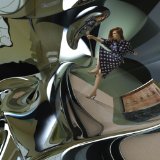 Nottingham-based Ronika has fashioned her debut album, named after the now closed record shop that stocked her essential loves and obsessions, after three crucial but somewhat lesser known albums made in the early part of the 1980s. Shannon’s “Let The Music Play”, Gwen Guthrie’s “Portrait” and, to a lesser extent, Cristina’s “Doll in the Box”. That’s electro-pop, disco, freestyle and boogie with some arch knowingness thrown in for the hell of it. American dance music made at a time of racial and sexual revolutions; soul music to linger in between the wink and kiss-off attitude, when people danced like it would save their lives. Ronika seems to get this relationship intrinsically and her album is one that also has a slightly unhinged quality which cements a clear persona and her mix of the old and new is wonderfully realised and, when it’s at its strongest, still fresh sounding.
Nottingham-based Ronika has fashioned her debut album, named after the now closed record shop that stocked her essential loves and obsessions, after three crucial but somewhat lesser known albums made in the early part of the 1980s. Shannon’s “Let The Music Play”, Gwen Guthrie’s “Portrait” and, to a lesser extent, Cristina’s “Doll in the Box”. That’s electro-pop, disco, freestyle and boogie with some arch knowingness thrown in for the hell of it. American dance music made at a time of racial and sexual revolutions; soul music to linger in between the wink and kiss-off attitude, when people danced like it would save their lives. Ronika seems to get this relationship intrinsically and her album is one that also has a slightly unhinged quality which cements a clear persona and her mix of the old and new is wonderfully realised and, when it’s at its strongest, still fresh sounding.
Recorded over a four-year period, “Selectadisc” features some material already heard on Ronika’s previously-released and well-received EPs and it’s some of the best music here. “In the City” is a fantastic song, a smoothly rolling ode to metropolitan night-time living; it gets under your skin and under your feet and is the kind of record that should have been huge and at one time would have been. “Video Collection”, “What’s in your Bag” and “Forget Yourself” are reminiscent of a Tom Tom Club/Gwen Stefani type of camp pop and are all essential. The two duets with Charles Washington, “Clock” and “Paper Scissors Stone” show a more experimental showy side and “1000 Nights” trips itself up only because it is very nearly a facsimile of Shannon’s tensely terrific “Give Me Tonight” and even then it’s still enjoyable enough. Ronika’s voice has occasional flashes of very early Teena Marie soulfulness but is smoother and less dramatic; make no mistake she can sing and comparisons to an early Madonna, at least vocally, sell her short.
With her arresting, canny and playful image Ronika falls into a category of idiosyncratic women who adore and emulate different forms of dance pop and understand the aesthetic of late eighties MTV. She is in good company with the likes of Annie, Roisin Murphy and the newly refreshed Kyla La Grange and displays an ability to write songs that are not only instant but those which also develop into lifelong soundscapes that accompany moments of invaluable dance-floor escapism. All of the really important dance music has done this, whatever the sub-genre and “Selectadisc” has a high count of great songs and a fun but involved groove grounding the majority. Ronika will be around for some time, it appears; her devotion to making and performing music seems inescapable and is irresistible. The UK dance scene – if such a thing still really exists – should welcome her with open arms.
 Glasser’s second full-length album is less touchy-feely than her indie electro 2011 debut, the wondrously rich and textured “Ring”. With lead singer Cameron Mesirow now cast as a high glamour, high concept academic, ‘”Interiors” is Glasser’s attempt to interpret human experiences with man-made environments, structures like New York’s Guggenheim maybe, and channel them into predominantly man-made music. It’s not as labour intensive as it sounds and on the whole is not a difficult album to listen to; it’s certainly more aloof than her previous work but concessions to a more nurturing and familiar sound do finally rise to the top. There is also a triptych of songs about windows.
Glasser’s second full-length album is less touchy-feely than her indie electro 2011 debut, the wondrously rich and textured “Ring”. With lead singer Cameron Mesirow now cast as a high glamour, high concept academic, ‘”Interiors” is Glasser’s attempt to interpret human experiences with man-made environments, structures like New York’s Guggenheim maybe, and channel them into predominantly man-made music. It’s not as labour intensive as it sounds and on the whole is not a difficult album to listen to; it’s certainly more aloof than her previous work but concessions to a more nurturing and familiar sound do finally rise to the top. There is also a triptych of songs about windows.
“Shape” opens up with languid, humming synths and swaying coos. It’s eerie but not alienating and is Glasser’s starting point before she reaches beyond her imagined comfort zone ‘I live on the beach, water surrounding me, and it’s got too deep …my home has no shape, nothing to sustain me, but it keeps me safe from imagined pain’. “Design” calls to mind Roisin Murphy’s work with Mathew Herbert in its vocal tics and sounds of machines trying to represent nature and design and the seductive use of strings and sliding synth effects on “Landscape” provoke and engage. “Keam Theme”, the one true dancer here, uses midtempo house beats and hi-hats and although Bjork references come far too easy (the similarities between this and “Vespertine” are numerous) it’s hard not to think of “Hyperballad” as its older, more street smart, sister.
The aforementioned “Window i” with its gentle pads and clicks is intimate but hollow and “Window iii” and “Window ii” (in that order) are both short and serve more as interludes but they are also redundant here. The promised visuals that are due to accompany the upcoming tour may help to explain their presence but, unaccompanied at least, it’s a minor experimental indulgence. More positively they also usher in the album’s recurring use of Cantonese mandolins which, along with saxophone, helps inject the steely soundscapes with human touches. Far-eastern musical influences were also heard in “Ring” but the tribal and more harmonious and inclusive sound of that collection is almost entirely absent from “Interiors”. The slower songs towards the album’s end are quite lovely though, “New Year” in particular has a surprisingly romantic and old fashioned melody with a traditional song structure and is in direct opposition to the somewhat lonely sounding, shiny and self-contained first half.
Glasser has made an album that positions her among the more experimental art-pop genre of electronic artists such as Julia Holter and Laurel Halo, it actually sees her sitting precariously between these two specific artists; the surreal, lyrical nature of Holter meets the electronic forward thinking soundscape obsessions of Halo. “Interiors”, however, falls short of its aims and ultimately doesn’t become the original and career-defining album that it could have been; the material is not consistently strong enough to permit this. Glasser will no doubt bring this music to life over the next year or so with touring and a continuation of the already captivating visuals we’ve seen with the ‘”Design” video and this is something to look forward to. The more intriguing prospect though will be where will Glasser go next; an exciting artist with her best material to come.
 A remix album that surpasses the original recording is a rarity indeed. For a relatively small scale, indie electronic band like Ultraista it feels perfunctory to issue one at some point and along with contemporaries such as Au Revoir Simone and Lali Puna, as well as big hitters like Bjork and Lady Gaga, the thing they all have in common is wildly varying levels of success and are all too often the ultimate exercise in self- indulgence.
A remix album that surpasses the original recording is a rarity indeed. For a relatively small scale, indie electronic band like Ultraista it feels perfunctory to issue one at some point and along with contemporaries such as Au Revoir Simone and Lali Puna, as well as big hitters like Bjork and Lady Gaga, the thing they all have in common is wildly varying levels of success and are all too often the ultimate exercise in self- indulgence.
Ultraista’s self-titled album, from which the remixers all derive their source material, was released last October and considering the enticing concept of Thom Yorke’s right hand man, Nigel Godrich, making female vocal lead electronica, the actual reception was not entirely ecstatic. It was glitchy and introverted, not necessarily intended on occasion I’m sure and partly due to Laura Bettinson’s vocals often being quietly pushed back into the mix, which undermined the impact of some of the stronger melodies. The main problem of what is still an interesting and thoughtful album is that, apart for the trip (predominantly) hop of slowed down “Party Line”, it was an album with little variation of beat, rhythm or structure. This album then is the ideal companion piece, bringing out the necessary colour and bite.
All ten of the original songs get a new treatment and unlike many other remix excursions there aren’t six versions of one particular track leading to repetitive ear strain injury early on (there are additional versions on the digital version though), with the majority thankfully not exceeding the five minute mark. “Smalltalk (Four Tet)” may stutter and rattle enthusiastically but the melody which was previously implied but not exploited now shines through and “Party Line(Canon Blue)” brings Bettinson’s vocal out of hiding and makes it a tight, bright thrill; the same applies to the now delightfully menacing “Easier (Zammuto)”.
“Static Light”, always one of their strongest tracks, was originally swamped by synths and drones and now Matthew Herbert turns it into a buzzing, tumbling pop rush reminiscent of his more major production work with Bjork and Roisin Murphy. Oddly now becoming better known as a prolific remixer (how exactly did this happen?) than a film director, David Lynch brilliantly turns the averagely competent “Strange Formula” into a dusty and scuzzy blues drawl. “Bad Insect” and “Our Song” don’t fare as well, being overwrought drum and bass and blissed out coffee table respectively, but two out of ten ain’t bad.
In many ways a template for the successful remix project, Ultraista have proved that there is still life in what is a really a marketing tool if quality control is paramount and the DNA of the original material remains; this is certainly the case here. This collection is cohesive and thoughtfully complied and if it in fact had been released in this format, it might have succeeded in making a stronger impression than the original recordings themselves. As it stands, the remixers have done an exceptional job in exposing Ultraista as the dynamic, quietly foreboding band that they have the potential to be.


